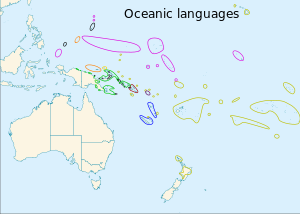| Temotu | |
|---|---|
| Geographic distribution | Solomon Islands |
| Linguistic classification | Austronesian
|
| Proto-language | Proto-Temotu |
| Subdivisions | |
| Language codes | |
| Glottolog | temo1244 |
 Temotu Temotu | |
The Temotu languages, named after Temotu Province of the Solomon Islands, are a branch of Oceanic languages proposed in Ross & Næss (2007) to unify the Reefs – Santa Cruz languages with Utupua and Vanikoro, each a group of three related languages.
Utupua and Vanikoro were formerly classified together as the Utupua–Vanikoro languages or Eastern Outer Islands languages (see Proto-Temotu language § Descendants).
History of classification

The Reefs-Santa Cruz languages had previously been considered Papuan, but Ross & Næss (2007) established that their closest relatives were the Utupua–Vanikoro languages, previously thought to be Central–Eastern Oceanic. However, Roger Blench (2014) argues that the aberrancy of Utupua and Vanikoro, which he considers to be separate branches that do not group with each other, is due to the fact that they are actually non-Austronesian languages.
Blench (2014) doubts that Utupua and Vanikoro are closely related, and argues that thus they should not be grouped together. Since each of the three Utupua and three Vanikoro languages are highly distinct from each other, Blench doubts that these languages had diversified on the islands of Utupua and Vanikoro, but had rather migrated to the islands from elsewhere. According to Blench, historically this was due to the Lapita demographic expansion consisting of both Austronesian and non-Austronesian settlers migrating from the Lapita homeland in the Bismarck Archipelago to various islands further to the east.
More recently, Lackey & Boerger (2021) finds no phonological evidence for an Utupua-Vanikoro subgroup, suggesting that they actually consist of two primary branches.
Languages
François (2009) notes that the lexicons of all three Vanikoro languages are highly distinct from each other and do not appear to be closely related, although their grammars are all similar.
References
- Ross, Malcolm and Åshild Næss (2007). "An Oceanic Origin for Äiwoo, the Language of the Reef Islands?". Oceanic Linguistics. 46 (2): 456–498. doi:10.1353/ol.2008.0003. hdl:1885/20053.
- Blench, Roger. 2014. Lapita Canoes and Their Multi-Ethnic Crews: Might Marginal Austronesian Languages Be Non-Austronesian? Paper presented at the Workshop on the Languages of Papua 3. 20–24 January 2014, Manokwari, West Papua, Indonesia.
- Lackey, William James; Boerger, Brenda H. (2021). "Reexamining the Phonological History of Oceanic's Temotu subgroup". Oceanic Linguistics. 60 (2): 367–411. doi:10.1353/ol.2021.0020. S2CID 244122506.
- ^ François, Alexandre (2009), "The languages of Vanikoro: Three lexicons and one grammar" (PDF), in Evans, Bethwyn (ed.), Discovering history through language: Papers in honour of Malcolm Ross, Pacific Linguistics 605, Canberra: Australian National University, pp. 103–126
| Languages of the Solomon Islands | |||||||||||||
|---|---|---|---|---|---|---|---|---|---|---|---|---|---|
| Official language | |||||||||||||
| Lingua franca | |||||||||||||
| Indigenous languages |
| ||||||||||||
| Austronesian languages | |||||||||||||||||||||||||||||||||
|---|---|---|---|---|---|---|---|---|---|---|---|---|---|---|---|---|---|---|---|---|---|---|---|---|---|---|---|---|---|---|---|---|---|
| Formosan | |||||||||||||||||||||||||||||||||
| Malayo-Polynesian |
| ||||||||||||||||||||||||||||||||
| |||||||||||||||||||||||||||||||||
This article about Oceanic languages is a stub. You can help Misplaced Pages by expanding it. |